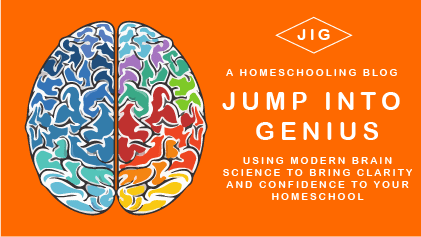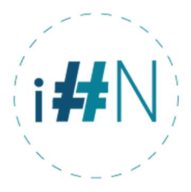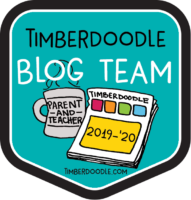One of the ultimate goals of schooling, or academic work, is the ability for abstract thought. We hope children will not only remember the things we teach them, but that they will be able to take concepts they have learned within the academic world and apply them, making connections both between subjects and also applying their knowledge outside of school. We hope knowing fractions helps them double a recipe. But it doesn’t always. Why not?
(You are reading the fourth post in a series about cognitive science in your homeschool, click here for the introductory post and links to the other posts in this series.)
First, the mind does not like abstract ideas, it likes the concrete, and so the first thing we do when faced with an abstract idea we cannot understand is we ask for an example. The example only helps if we already have knowledge of the example, and most of the things we have knowledge of are concrete.
The best way to help anyone to understand an abstraction is by connecting it to many various concrete examples. One example is not enough to uncover the pattern of the connection, and so it does not reveal which part of the example is the outer part, and which part is the inner heart of the abstract idea.
A concrete example of this idea is the area of a rectangle. A child is more likely to understand the concept deeply if they are asked to solve the area of many different kinds of rectangles, such as table tops, soccer fields, paper, screens, etc. After solving many problems, always being drawn back to the idea of how you find the area of a rectangle, they will be more likely to be able to apply the concept again when met with a similar problem, no matter what the rectangle is represented by, or even if it has no concrete representation.
Understanding is Remembering in Disguise. Willingham
When our students do not understand the concepts we are trying to teach them, we need to provide examples. If there is a question they are struggling with, and we do not wish to deprive them of the joy of solving the problem, we can turn to example and analogies. We can solve similar problems, without interfering with their mission to answer their problem. They need help, but they usually do not need us to directly answer the problem.
Our examples and analogies have to be things the child is familiar with.
It’s not the concreteness, it’s the familiarity that’s important, but most of what students are familiar with is concrete because abstract ideas are so hard to understand. Willingham
Understanding a new idea happens by getting old ideas into working memory, moving them around, and thinking about them in new ways. New comparisons, new connections,
old ideas + new comparisons + new connections = understanding new ideas.
This is why Willingham says that understanding is just remembering in disguise. It is also why learning doesn’t happen when we view a child’s brain as an empty bucket that we just need to pour a bunch of knowledge into. They aren’t empty, and we need to work with what’s in their to get new stuff added. It is slow and laborious because it requires thinking. When we rush too much in, nothing sticks, because the student does not have time to think about most of it, so it is disregarded as unimportant by the brain.
We have two ways to help our kids understand abstract ideas. One, help them pull up the information from long-term memory that they are going to need to use to understand the idea. Two, make sure they are comparing the concrete examples to the abstract idea in the right way. This is another reason why multiple examples are usually needed. One example on its own can easily be misunderstood. Multiple examples help the student see the idea behind the example.
If the student can only tie the idea to one example, their knowledge remains shallow. They may have it stored in memory, but they have not learned how to think about the idea. When they can apply the idea to multiple examples and situations, they have gained a deep knowledge of the idea. It is not only in memory, but they know how to use it in new ways when needed. The more we can connect an idea to other ideas, and show the child the whole idea, instead of just pieces, the more they will be able to have this deep knowledge. If they understand the examples, the abstraction, and how they fit together, then they have deep knowledge.
If someone has a deep knowledge of how a car works, they will be able to predict what would happen if any piece of the car was changed or removed.
In Your Homeschool
“If understanding were easy for students, teaching would be easy for you!” Willingham
Use lots of examples to help students see the deep structure. Comparing different examples may help by forcing them to think about the deep structure of the problem. (Willingham goes into detail about deep structure versus shallow structure of problems in his book.)
Focus on deep knowledge. This means we ask questions that require more than low-level factual knowledge. Yes, we have to make sure they have that low-level factual knowledge they need, but then we take it deeper, leading them to an understanding of connections and the bigger picture. If we test or ask only about the facts, our kids will think it is only the facts that matter. We emphasize the importance of deep knowledge by asking questions that require it, and if we test, or in whatever way we test, ask those hard questions. The ones you know they will not be able to answer if they don’t have deep knowledge.
Perhaps the hardest thing we have to do is accept that deep knowledge is hard, takes practice, time, and a lot of hard thinking work. There is no quick-fix way to get deep knowledge. We have to be realistic in our expectations of how quickly our children will be able to get to this level of knowledge.
Shallow knowledge paves the way for deeper knowledge, and our job is to help them start and keep them moving forward towards deeper understanding.
This is just a short explanation of the concepts covered by Willingham. There is so much more in his book, and I strongly recommend reading it. One thing Willingham does in his book is take you through many more examples, persuading you as he introduces each idea. If I had a top ten books home educators should read, this would be on it.


